The LG G3 Review
by Joshua Ho & Anand Lal Shimpi on July 4, 2014 5:00 AM EST- Posted in
- Smartphones
- LG
- Mobile
- Laptops
- G3
Rear Camera Performance
Spatial Resolution
We'll start by measuring the rear facing camera's ability to resolve fine details by shooting at an ISO12233 test target. For now we'll be looking at horizontal and vertical resolution using the sagittal and tangential lines in the upper right of the center of the test chart:
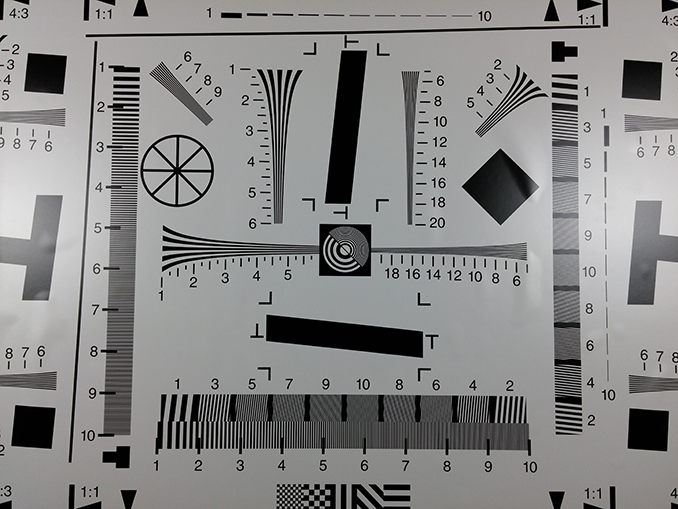
ISO 12233 Test Chart Captured by the LG G3
The gallery below has links to the original chart captures for all of the phones compared in this review:

The G3 does a good job of resolving fine details. The Galaxy S5 is a bit better, but the G3 is much better than its other competitor: the HTC M8. There's not really any improvement here over the G2 thanks to LG's sensor re-use. We do see a bit of difference in LG's white balance at work but in terms of usable resolution, the G3 performs quite similarly to the G2. There are some slight differences in how aliasing appears in the G3's chart but not substantial enough to make a big deal about.
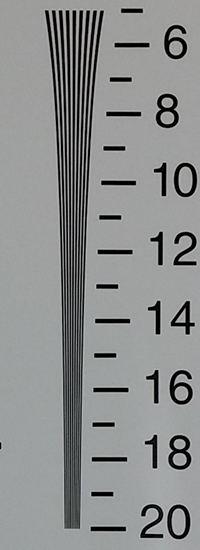
The tangential crops tell a similar story. The G3 doesn't really move the needle compared to the G2, but that's not bad at all. Compared to modern Android flagships, the G3's ability to resolve fine details is quite competitive. I actually wonder if somewhere in the 10 - 13MP range may be the sweet spot, perhaps with slightly larger pixels.
Color Reproduction
LG continues to strike a good balance between vibrant and accurate colors. When properly exposed, the G3's color performance is solid. Grayscale reproduction also looks good. There's a bit more noise than I'd like to see in the swatches but overall the G3 does a good job in this test:
Lab Scenes
In our light controlled lab scene we really see how little has changed between the G2 and G3 cameras. The G2 had a longer capture period at 1/30s compared to 1/40s on the G3, but the results are largely similar. The G2 was a very strong performer, as is the G3.
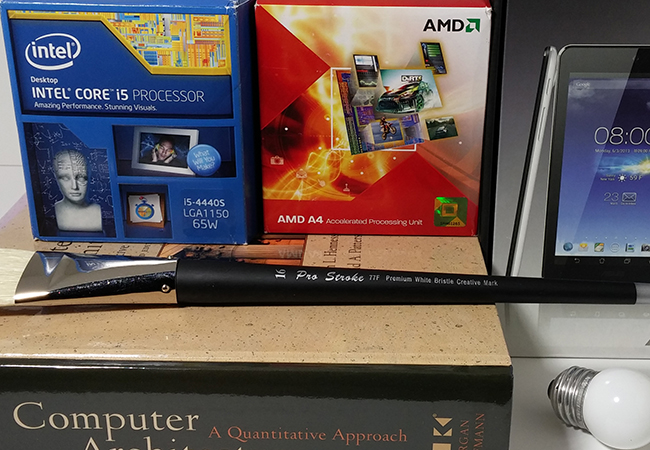
Low light performance was a strength of the G2 due to whatever binning or exposure combining LG did in low light conditions. The G3 continues the trend, although it seems to have a faster shutter speed resulting in a slightly darker scene.
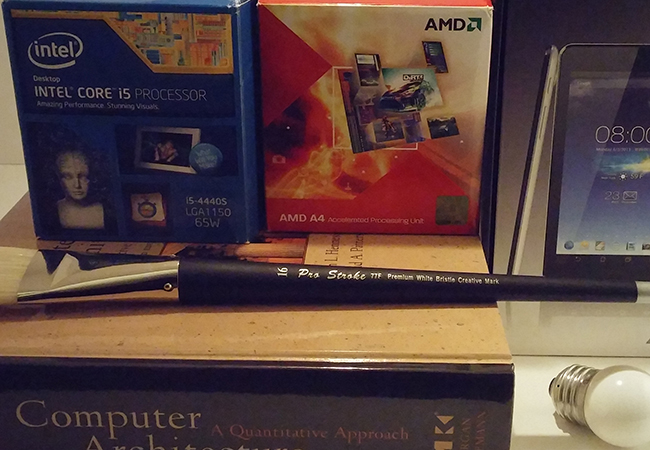
Outdoor Scenes (Night)
Next we transition to some shots on location. First up is the same night shot of a storefront that we used in the Galaxy S 5 review:

Although the lab scenes looked pretty comparable, on location there are substantial differences between the G2 and G3. The G3 definitely does a better job with white balance and color reproduction.
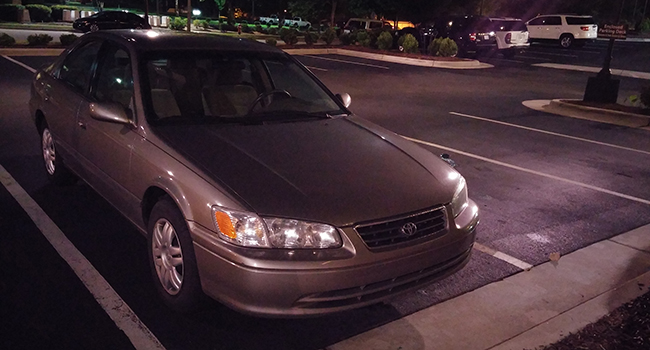
The performance difference is less in favor of the G3 in this shot but overall performance is still better than the Galaxy S5.
Outdoor Scenes (Daylight)
We ran through a new set of locations on the four main Android shooters here. I've pulled out one of the best comparisons below:

The G3's color handling is so much better than on the G2. The latter has more of a blue overcast while the G3's image looks much more natural. The Galaxy S5 by comparison is appreciably sharper (look at the detail in the speed limit sign in the background).
Capture Latency
LG, HTC and Samsung all went to great lengths this generation to reduce focus acquisition latency on their flagships. I believe HTC is partially leveraging its DuoCam sensor as well as a secondary ISP, Samsung turned to Phase Detect AF and a secondary ISP, while LG looked to an IR range finder to help speed up focus acquisition. We've been measuring focus latency over the past few flagship reviews and put the G3 through the same test. Here I used the same ISO 12233 target setup we used for spatial resolution tests but measured average focus acquisition time for a number of points on the chart.
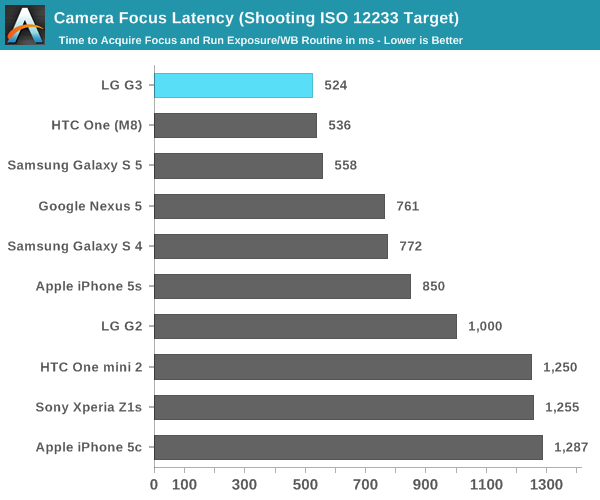
The G3's performance is so much better than the G2, you can grab focus in around half the time now. Compared to the M8 and GS5, the G3 is perhaps a bit quicker. I measured lower minimum focus acquisition time on the G3 than on either flagship, but on average the performance is quite similar to what HTC and Samsung deliver - at least in this test.
Quickly acquiring focus is just one aspect of overall camera latency. How quickly the device can actually capture an image is almost as important. Here we're looking at the time between tapping the shutter button and when the camera UI is responsive again (this is how all devices in this chart, with the exception of the One mini 2, are measured). Another metric that's useful in looking at is how long before the resulting photo is available in the gallery, for the G3 I've included both datapoints. The One mini 2's data corresponds to the latter metric exclusively as the camera UI behaves as if it's immediately responsive after capture but in reality isn't.
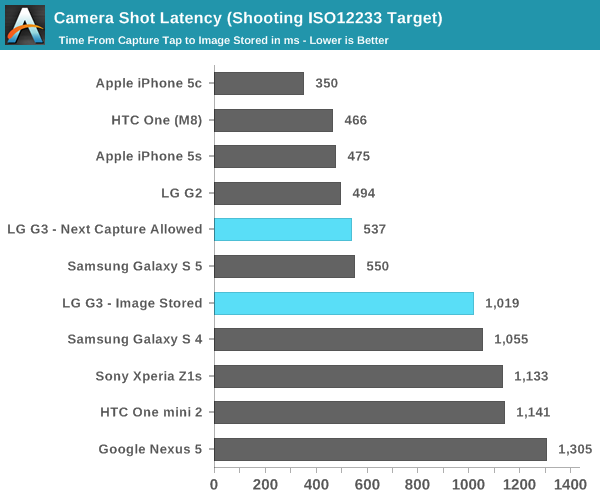
The G3 seems to regress a bit compared to the G2 but overall its peak performance looks decent. If you want immediate access to the captured image you will have to wait about a second, but in reality by the time you tap on the captured image and pull up the gallery you'll exceed this 1019ms latency. Bringing up the gallery is definitely the bottleneck here.
This next chart simply adds the previous two numbers together to provide a look at total camera latency:
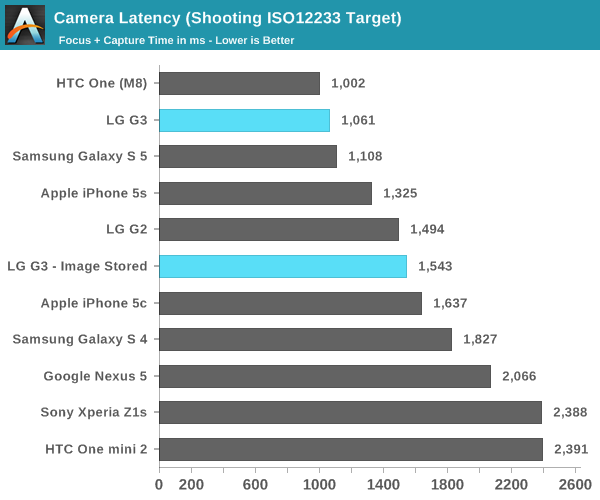
The G3 is quite competitive with the 2014 Android flagships when it comes to overall camera latency. The improvement compared to the G2 is substantial.
Video
The G3 can shoot 4K video at 30 fps and it does so at roughly 30Mbps, up from 20Mbps when shooting 1080p30 video. I included a couple of samples that also engage the device's OIS+:






















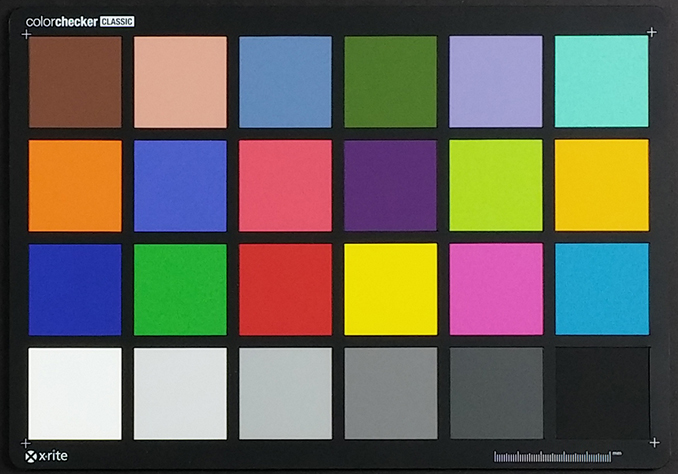






























































174 Comments
View All Comments
boe - Thursday, July 10, 2014 - link
This is a nice review but it would be great if the battery life chart showed talk time. I know it is crazy, but I use my phone to make phone calls.AncientWisdom - Thursday, July 10, 2014 - link
No way! oOHrel - Thursday, July 10, 2014 - link
Pretty glad I got the G2 this year, this phone sucks. 5.5" really? The G2 is already a bit too large and I have huge hands. 4.7" is probably the ideal size. They need to stop going beyond that.Perhaps because of LG's slim bezel chassis they can go larger, but certainly no larger than 5".
CampoX - Friday, July 11, 2014 - link
I was up for a G3 but after my Ultra died in my pocket this review was the reason I went for an M8 this week.goobersnatcher - Saturday, July 12, 2014 - link
If LG would have kept the size of the G2 and went 1080, QC 805 and made it the next Nexus .... I'd be all over this phone!andredogg - Tuesday, July 15, 2014 - link
Just bought this phone 4 days ago and I must admit it grows on you quickly. Selfie cam looks like a mirror my s5 active selfie cam is not in same league. And if your LG g3 is dim turn off auto brightness. Also like that every icon can be replaced by any pic or icon you find by holding down icon and releasing it and touching little paintbrush. overall experience is great. Also the 2k screen is amazing if you find content to play on it. Knock codes are also useful.yvn - Tuesday, July 15, 2014 - link
I had a chance to check out the display of LG G3 yesterday and oddly I have to disagree with Anand on its color reproduction. Not sure about the charts and other tests he did but it extreme close in color reproduction to my iPhone 5s and with just a tad more on red tones but then I know the iPhone 5s has a little weakens with reds and greens hues, so in other words the colors on G3 is spot on! hmm....Samsung even in "movie" mode looks way off so I am not sure how Anand claims in the review that Samsung has best display??? I am sure it is not so!soldier4343 - Thursday, July 17, 2014 - link
Handled one yesterday in store and its a great device. Waiting for the Note 4 in September to see what changes they made before upgrading which I do once a year.SpartyOn - Saturday, July 19, 2014 - link
Not a single Windows Phone for battery life comparison. It's like being a parent: I'm not upset... just... disappointed.Thanks Anandtech for continuing to promote a mobile phone OS duopoly.
deV14nt - Sunday, July 20, 2014 - link
I'm surprised the Galaxy S5 brightness was not measured with auto on. DisplayMate measured the max brightness at 698 nits with auto on, the brightest display they've tested, beating out the Note 3 by about 50 nits.It also would have been nice to see the G3 auto focus tested at less than 2 feet, to see the laser AF at its best conditions.